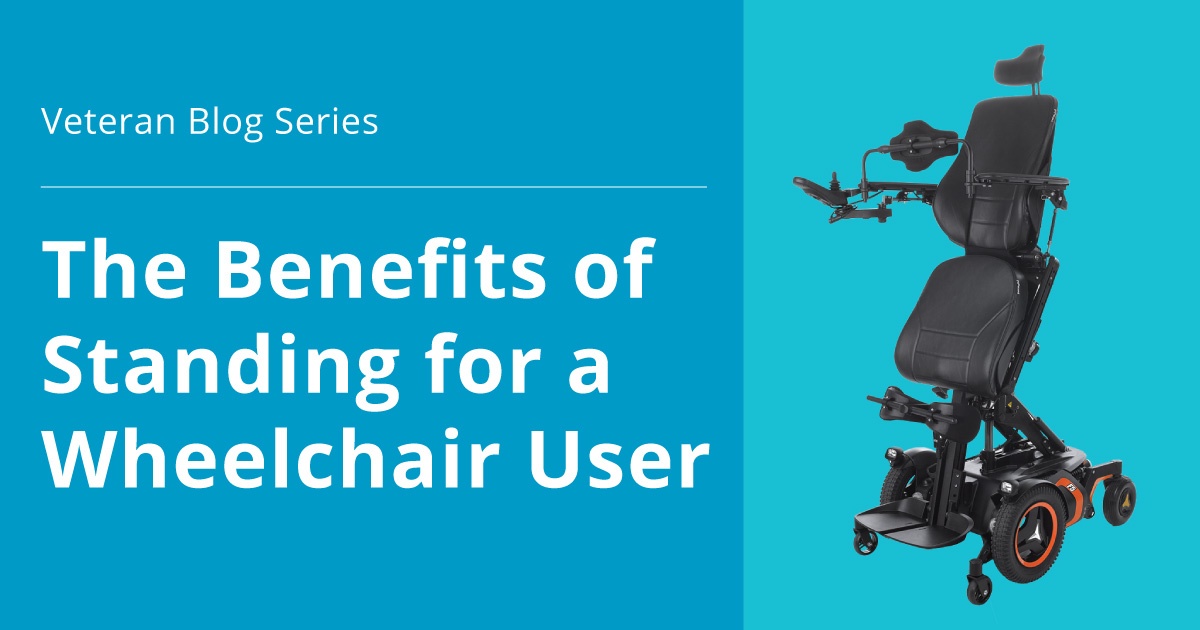Part 2 in our series focusing on wheelchair solutions for Veterans. See Part 1 here. For more information on Standing Wheelchairs, check out Landon's Journey to Standing.
If you work in an office setting, you’ll notice that there is an increased push towards standing desks and even treadmill desks. It has been well documented that prolonged sitting affects your health. So, if this is true for able-bodied individuals, it is certainly true for a wheelchair user.
The seated posture basically compresses all the internal structures. Gravity essentially makes our everyday physiological processes less efficient when sitting because of this compression. When standing, however, gravity assists these physiological processes and helps the body function better.
There are several secondary complications from prolonged sitting: pressure injuries, bowel and bladder problems, difficulty breathing, poor circulation, and muscle tightness to name a few. Today we’re going to look at the many benefits of standing for a wheelchair user.
The Benefits of Standing for a Wheelchair User

Increased Bone Density
Weight-bearing and good nutrition causes our bones to get stronger. Bone density can decrease with age and inactivity, which makes the bones more susceptible to fractures. Standing and bearing weight can help maintain and prevent loss of bone density, which can make the bones in the legs strong.
Improved Circulation
Movement is what helps the blood to flow through the body. By sitting all day, the circulation in the legs will decrease, which can potentially lead to swelling and even to blood clots. Standing promotes improved blood circulation throughout the whole body.
It Promotes Skin Health
Standing relieves pressure at both the seat and back surfaces and allows oxygenated blood to reach the area. This maximizes skin health and will decrease the risk of pressure injury.
Improved Bowel Function
Bowel accidents can happen when bowel function is involuntary. Standing allows gravity to help digestion and can activate the stomach muscles to help prevent accidents.
Better Bladder Management
Being seated all day can result in poor emptying of the bladder. This can then result in urinary tract infections, leakage, and incontinence. Standing can improve the emptying of the bladder and minimize the need for bladder medication.
It Prevents Tight Muscles
Sitting in a similar posture every day results in our muscles shortening or lengthening to adapt to that posture. Standing allows passive movement of the hips, knees, ankles, and trunk, which results in decreased tightness and muscle spasms.
Higher Quality of Life
Perhaps the most significant benefit of standing is that it enhances your quality of life. Not only does it decrease the risk of physical complications already mentioned, it can improve your mood by allowing face-to-face conversations. It increases independence by allowing you to reach for items and be an active part of daily routines. Think about “walking” your daughter down the aisle and being able to look at her eye-to-eye. Think about hunting with your friends and being able to achieve different positions and postures to get that perfect shot. Having access to a standing wheelchair should not be viewed as a “luxury.” As Per Udden, the founder of Permobil, said as the foundation of his company: “Every person has the right to have his or her disability compensated as far as possible by aids with the same technical standard as those we all use in our everyday lives.” Check out the options that Permobil has to provide you with your best life possible!
1. Ellis, M. (2018). The Benefits of Standing After Spinal Cord Injury. Retrieved from https://www.spinalcord.com/blog/the-benefits-of-standing-after-spinal-cord-injury
2. Doolin-Carver, A. (2012). Standing Tall Post-Injury - Rehab Managment. Retrieved from http://www.rehabpub.com/2012/11/standing-tall-post-injury/

Stacey Mullis, OTR/ATP
Director of Clinical Marketing
Stacey is Director of Clinical Marketing. She graduated from Western University in London, Ontario, Canada with a BA Linguistics and BSc Occupational Therapy and has practiced as an OTR for over 20 years. With experience in pediatrics, inpatient/outpatient rehabilitation, long term care, and home health, Stacey has faced the challenges first hand of providing appropriate seating in various clinical settings. This led her to pursue an apprenticeship at Care Partners Seating Clinic in Asheville, NC to advance her skills, and she obtained her ATP certification in 2012. Mullis is a member of the NCOTA, CTF, NRRTs, RESNA, and AOTA.

